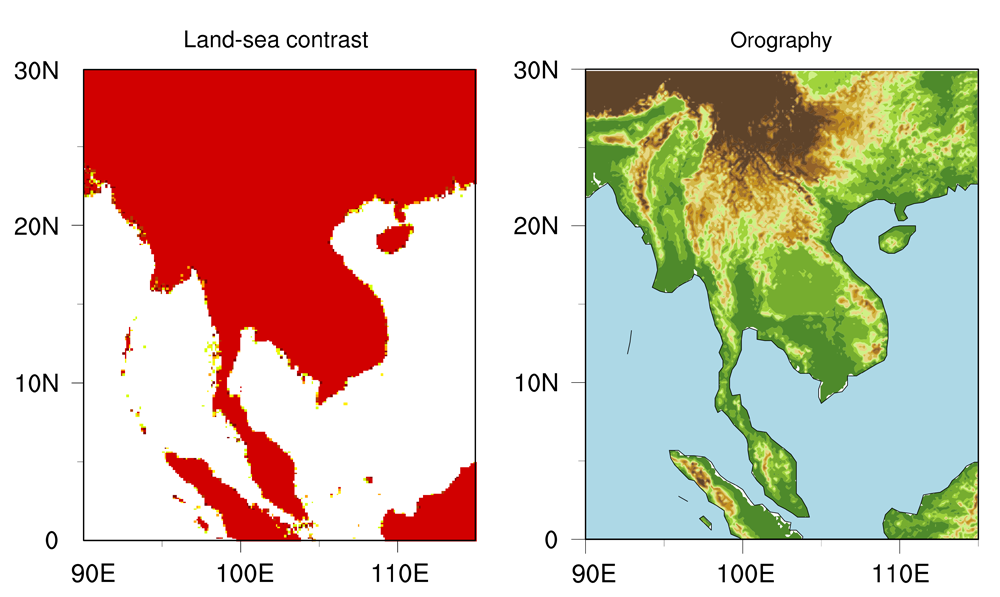The extension of the Asian subtropical continent into the tropics, including the Indochina Peninsula (ICP), is generally considered an important agent for inducing and maintaining the Asian summer monsoon (ASM), in addition to the planetary-scale land-sea thermal contrast and vast mountain ranges.
"The ICP has a critical effect on organizing monsoonal winds and precipitation." Said ZHUANG Moran, a Postdoctor from the Institute of Atmospheric Physics under the Chinese Academy of Sciences and the lead author of a study recently published in
Journal of Climate. "Early studies in this regard mainly focused on the role of the land-sea thermal contrast over the ICP in early summer with a coarser-resolution model. The complex role of the ICP's orography in the ASM has not been explored extensively."
The land-sea contrast and orography over the Indochina Peninsula. (Image by ZHUANG Moran)
To fully understand the seasonal response of the ASM to the ICP, instead of focusing on only one factor and one summer stage, ZHUANG along with her collaborators used an atmospheric general circulation model of finer resolution and examined the differences in the response of the ASM to both the orography and land-sea contrast over the ICP between early and late summer.
They found that the orographic effect increases South Asian rainfall and reduces the rainfall over the South China Sea (SCS) and North China in early summer, but its influence on monsoonal circulation and rainfall is limited to East Asia in late summer. The impact of the ICP's land-sea contrast is basically opposite in the two summer stages. With the presence of the ICP, SCS rainfall is enhanced but South Asian rainfall is weakened in early summer. In late summer, however, rainfall from the ICP to the northwestern Pacific is strikingly reduced, accompanied by intensified rainfall over South Asia.
The team went further to identify the relative importance of the narrow mountains and land-sea contrast of the ICP and investigate the underlying physical process behind the impact of the ICP on the ASM. They found the orographic effect seems to be more important in modulating the South Asian monsoon in early summer while the land-sea contrast is dominant in strengthening the SCS monsoon and suppressing the Northwest Pacific monsoon via the interaction between the induced local circulation and multi-level ASM subsystems. In late summer, the orographic effect on the ASM is much weaker compared to the land-sea contrast, which plays a critical role by shifting the subtropical high southwestwards and through the "thermal adaption" feedback mechanism.
"The orography and land-sea contrast over the ICP have profound but different impacts on the ASM. The study revealed different monsoon circulation and precipitation response to the topography and land-sea thermal contrast over the Asian subcontinents in two summer stages. This helps us better understand the interaction between the ICP and the ASM." Prof. DUAN Anmin, the corresponding author of the paper said.
Citation:
Zhuang, M., Duan, A., Lu, R., Li, P., & Yao, J. (2022). Relative impacts of the orography and land–sea contrast over the Indochina Peninsula on the Asian summer monsoon between early and late summer, Journal of Climate (published online ahead of print 2022). https://doi.org/10.1175/JCLI-D-21-0576.1
Media contact: Ms. LIN Zheng, jennylin@mail.iap.ac.cn

